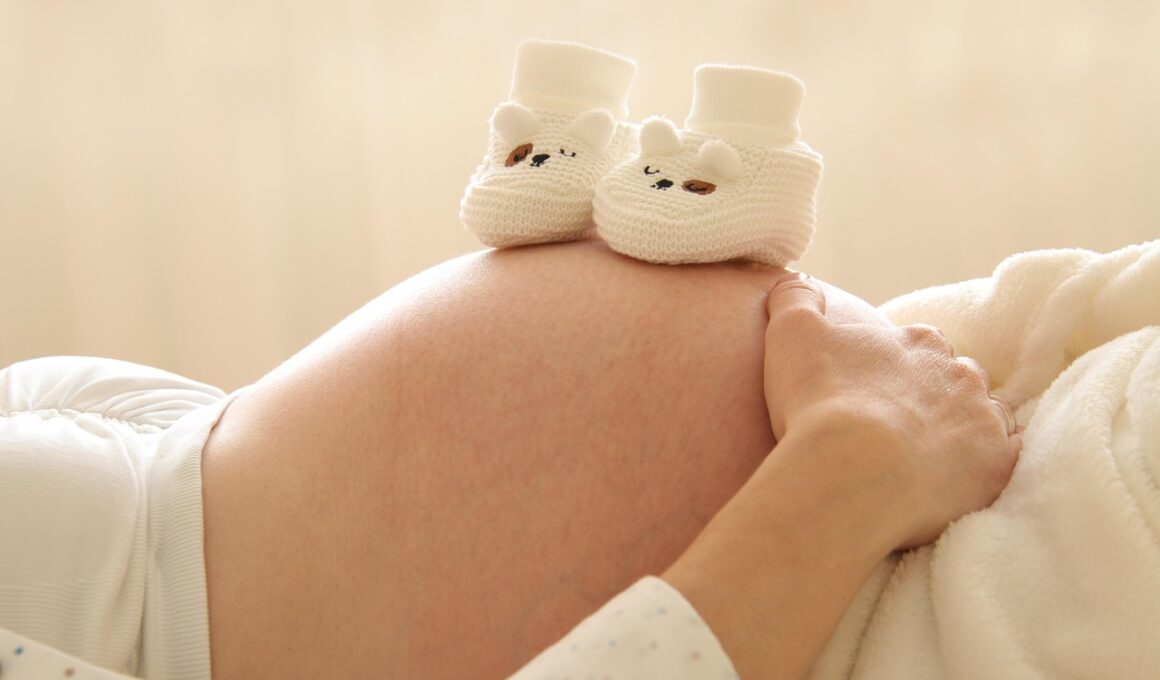Staying Active: Pilates Exercises for Pregnant Women with Limited Mobility
Pregnancy is an incredible journey, and staying physically active is vital for both the mother and baby. For women experiencing limited mobility, Pilates offers a gentle yet effective way to maintain fitness. Tailored to accommodate different physical abilities, these exercises can be modified to suit each individual’s needs. Utilizing controlled movements helps build strength and flexibility while reducing discomfort in various areas of the body. Women with limited mobility can greatly benefit from Pilates as it focuses on enhancing core stability and overall body awareness. Additionally, these exercises encourage deep breathing, which fosters relaxation while promoting a sense of well-being. It’s crucial to consult with a healthcare professional before starting any new exercise routine during pregnancy. A qualified instructor skilled in prenatal Pilates can correctly assess your abilities, ensuring that the program is safe and beneficial for you. Engaging in regular practice can enhance mood, alleviate prenatal anxiety, and improve sleep quality. Discovering Pilates could be a transformative experience for many pregnant women, allowing them to embrace their bodies during this beautiful phase of life.
One of the fundamental principles of Pilates is the emphasis on proper posture and alignment. This emphasis allows pregnant women to develop better body awareness, which is particularly crucial during pregnancy due to the physical changes occurring. Understanding and practicing good alignment helps alleviate common discomforts associated with pregnancy, such as lower back pain and pelvic discomfort. Modified exercises can target these areas effectively, providing relief and increasing strength. Furthermore, engaging the pelvic floor muscles through targeted movements enhances stability, supporting the body as it adapts to the growing baby. A series of breathing techniques incorporate appropriate inhalation and exhalation methods, which can also be beneficial during childbirth. This practice can help manage stress levels and enhance relaxation, promoting a greater sense of calm throughout pregnancy. Incorporating movements that promote hip opening and stretching will engage various muscle groups safely, while allowing each woman to tune into her own body’s needs. Pilates empowers pregnant women, instilling confidence as they progress through their pregnancy journey. Through focused attention on breath and body awareness, Pilates nurtures both physical and mental wellness, making it an excellent choice for expectant mothers.
Essential Pilates Exercises for Limited Mobility
Pilates offers several specific exercises well-suited for pregnant women with limited mobility. One effective movement is the seated cat-cow stretch. Start sitting up tall with legs crossed; gently arch and round your back in a cyclic manner. This exercise stretches the spine and encourages fluid movement. Another beneficial exercise is the side-lying leg lift, promoting hip strength while maintaining a comfortable position. Lying on one side, lift the top leg, keeping the lower leg steady. Focus on slow, controlled movements while maintaining a straight line from head to toe. Additionally, the gentle pelvic tilt can be advantageous; lying on your back with knees bent, engage your core, and tilt the pelvis towards the ceiling. This helps strengthen and stabilize core muscles while alleviating tension. A great option is the modified bridge pose, elevating the pelvis while keeping the shoulders relaxed. It promotes lower back strength and opens the hip flexors. Remember, always listen to your body, resting as needed, and consult a prenatal Pilates instructor. Engaging in these exercises can enhance overall well-being and cultivate strength during pregnancy.
Incorporating the principles of breathwork is essential when practicing Pilates during pregnancy. Deep, intentional breathing enhances relaxation and reduces anxiety while helping expectant mothers connect better with their bodies. Focusing on diaphragmatic breathing encourages a sense of calm, making it easier to perform gentle Pilates exercises. Incorporating breath into movement ensures that each exercise is executed mindfully, allowing for a more effective workout. Aim to inhale as you prepare for a movement and exhale as you execute it. This breath rhythm aids in maintaining energy levels and enhances focus throughout the practice. Additionally, integrating visualizations or affirmations can improve mental clarity, making the experience even more enriching. Practicing Pilates regularly while emphasizing breath can dramatically improve physical health and mental well-being. Expecting mothers will likely notice an increased ability to cope with stress and discomfort, which can translate into a more positive pregnancy experience overall. Prioritizing breath allows women to cultivate a deeper mind-body connection, making their Pilates practice feel more aligned and supportive. As the journey progresses, these techniques will continue to provide invaluable insights into personal awareness, nurturing both physical and emotional strength for motherhood.
The Benefits of Pilates for Posture and Core Stability
Maintaining strong core stability is one of the many advantages of Pilates, greatly benefiting pregnant women, particularly those with limited mobility. A well-developed core supports the entire body and helps reduce the strain on the back and pelvic region. This becomes increasingly important as pregnancy progresses, where posture shifts due to the growing belly. Improved posture enhances overall balance, making daily activities feel easier and more manageable. Pilates exercises are designed to reinforce the deep muscles in the abdomen, lower back, and pelvic floor, creating a solid foundation for movement. Another advantage of practicing Pilates is its focus on flexibility. Stretching exercises help relieve tension and discomfort, allowing women to experience greater ease in their bodies. Coupled with core strengthening, these two elements work hand in hand to contribute to a more enjoyable pregnancy experience. Furthermore, practicing Pilates instills confidence in women as they learn to move carefully and efficiently. This newfound body awareness can foster positive connections with their changing shape. Embracing Pilates during pregnancy ultimately helps prepare women for the physical demands of motherhood, emphasizing resilience and strength throughout the transformative journey ahead.
It’s essential for pregnant women with limited mobility to practice Pilates safely. Modifications should be made whenever necessary to suit individual needs, ensuring an enjoyable experience. Always prioritize your comfort, steering clear of positions causing pain or discomfort. Utilizing props like cushions or resistance bands can enhance accessibility, allowing more tailored movements. If a position feels too difficult, find an easier alternative or reduce the intensity. Communicating openly with a certified instructor is crucial; they can help adjust exercises to maintain effectiveness while avoiding strain. It’s vital to listen to your body and honor its signals. If you experience any concerning symptoms such as dizziness or excessive fatigue, stop immediately, consult a healthcare provider, and modify your practice accordingly. Joining a class specifically designed for pregnant women can provide additional motivation and connection to others experiencing similar journeys. Personalizing your Pilates routine allows for a customized program that feels both rewarding and safe. Above all, stay patient with yourself during this phase—celebrate small achievements and relish each moment of the journey into motherhood. Embracing this empowering practice nurtures strength and enhances well-being in every aspect of life during pregnancy.
Creating a Sustainable Pilates Routine During Pregnancy
Developing an ongoing Pilates practice during pregnancy can yield long-lasting benefits. To create a sustainable routine, consider setting aside specific times each week to dedicate to your practice. Consistency is key, but it doesn’t have to be overly rigid. Aim for a flexible structure allowing room for adjustments when necessary. Find engaging online classes or instructional videos focusing on prenatal Pilates, ensuring you’re learning movements suitable for limited mobility. This approach allows you to practice in the comfort of your home while catering to your unique needs. Additionally, consider partnering with a friend, spouse, or support person to help make your Pilates sessions more enjoyable. Encouragement from loved ones can make it easier to stick to your routine and create a supportive atmosphere during practice. Keeping track of your progress in a journal highlights developments in your strength and flexibility—celebrating accomplishments along the way. Stay open to modifying your exercises as your pregnancy progresses, continuously adapting to your evolving body. Remember that this experience is a significant journey toward motherhood, and your Pilates practice enhances physical, mental, and emotional wellness for you and your child.
In conclusion, Pilates serves as a remarkable tool for pregnant women looking to stay active, particularly those with limited mobility. Offering numerous benefits, this safe, low-impact form of exercise emphasizes mindful movement and sound body mechanics. By focusing on core stability, flexibility, and breath, women can nourish themselves through this transformative time, instilling confidence and promoting overall well-being. Practicing Pilates promotes physical, mental, and emotional health, making it a crucial part of any expectant mother’s self-care regimen. Encourage engagement in supportive communities, whether through classes or online forums, for motivation and connection. Being proactive and nurturing oneself during pregnancy fosters lasting positive effects on both mother and baby. With guidance from qualified instructors, women can confidently explore their bodies while developing strategies to manage discomfort and promote relaxation. As each woman commits to this empowering practice, they can better appreciate the unique journey of motherhood. Let Pilates be an integral part of this period, encouraging strength, resilience, and joy throughout the transformative experience of pregnancy.


